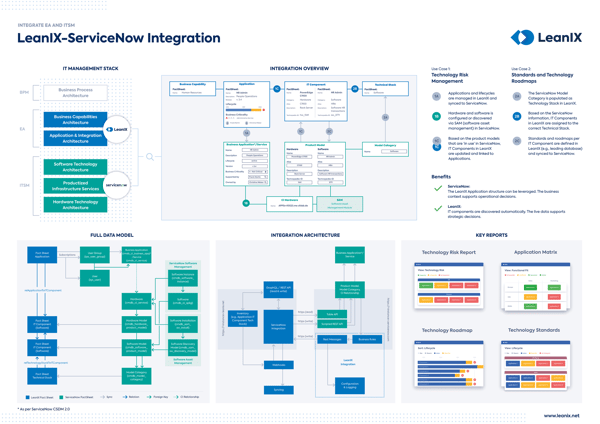
Diagram To Data: Leveraging AI’s Greatest Capability
SAP LeanIX AI can analyze your enterprise architecture diagrams and use them to populate your information repository. Discover this powerful new EA tool.
Build and transform technology landscapes to support evolving business strategies and operationalize innovation.
Learn moreSAP LeanIX Customers
A growing list of industry leaders and organizations of all sizes who trust in SAP LeanIX
See Full ListMaximize market potential through a partner program offering LeanIX solutions tailored to your business model.
Learn moreTake your capabilities to the next level and arm yourself with the knowledge you need
See all resourcesGet to know everything about what IT Service Management (ITSM) is, the importance of ITSM and everything about different ITSM Processes.
The digitalization of traditional business models has created a need for new management approaches that are dynamic, automated and adaptable. With its process-oriented approach, IT Service Management makes sure that IT assets are not only delivered to the customer but also used in the most effective way.
By ensuring that all activities in IT departments align with an organization’s mission, managed IT service processes also maximize a company’s business value and thus, affect its overall success. With the decline of centralized systems and the rise of distributed systems, ITSM has become the go-to framework for managing varied integrated services.
IT Service Management or ITSM encompasses all activities that involve the design, creation, delivery, support, and lifecycle management of IT services. Unlike other IT management approaches, ITSM is characterized by defined processes that address both customer and business needs.
But what exactly makes ITSM different from traditional IT management? The answer lies in its dynamic but repeatable processes and its continuous effort to improve the status quo. While other approaches focus on the technology itself and react once IT problems arise, IT Service management regards IT as a service that needs to be delivered to the customer. It’s also built on a set of principles that allow for proactive and preventative management. These principles are rooted in ITIL, the Information Technology Infrastructure Library.
As ITSM goes beyond fixing day-to-day technical issues, it reaches much further than standard IT support. It’s the end-to-end management of IT services and makes sure that all activities within IT departments are aligned with overall business goals. This also means that ITSM frameworks and practices are used enterprise-wide and that IT teams don’t work in silos. Instead, they oversee all workplace technology from laptops to business-critical applications, and take responsibility for all associated risks and costs.
Thus, IT Service Management can be described as a cultural mindset where the focus lies on treating users as customers and creating value through the continuous improvement of existing IT processes. In practice, this isn’t as abstract as it sounds. ITSM teams usually work with workflow management systems like ServiceNow that allow them to apply best practices when dealing with IT service requests or incidents. These platforms usually consist of a service catalog and a configuration management database.
There are many reasons why more and more businesses have been adopting ITSM. One of them is rooted in the fact that there are higher industry standards when it comes to the digital performance of an organization. Thus, companies rely more on distributed or decentralized computing and less on centralized systems. This has created a demand for a new IT management approach that streamlines IT processes within the enterprise. With a focus on varied integrated IT services that meet critical business goals, ITSM has largely replaced more technology-focused stand-alone practices.
With cloud computing on the rise, it’s not surprising that IT Service Management is now a vital tool for companies who compete in a digitalized marketplace. Ideally, ITSM provides the IT department with clear service management principles that are in line with business priorities. Through standardized practices and proper documentation, issues can be resolved more efficiently and traced back when needed. This empowers IT teams to share their knowledge and to continuously improve IT processes in a customer-centric way. ITSM also facilitates cross-department collaboration and avoids insular ways of thinking.
As IT Service Management works across the whole lifecycle of a service, from design to live operation, there are fewer blind spots compared to traditional reactive IT management styles. However, ITSM does not only support IT teams and other departments within the enterprise. Being able to quickly respond to small and big incidents improves customer satisfaction and prevents similar problems in the future. And delivering IT services based on resources, budgets and results end up increasing efficiency and productivity while reducing costs and risks. Ultimately, this increases the overall value of a business.
As already mentioned, ITSM processes are based on the Information Technology Infrastructure Library also known as ITIL. The Library was developed by the UK Government’s Computer and Telecommunications Agency in order to standardize IT management practices.
It’s important to note that ITIL doesn’t make the rules for IT teams, but it rather offers them recommendations and guidance on how to set up a framework with repeatable procedures that will lead to a more efficient service. Some of the most important processes are summed up below.
IT teams often deal with service requests that are predictable and reoccurring. If there is a repeatable procedure in place, these requests can be handled in an efficient manner.
The ITIL defines service requests as all incoming inquiries that ask for something new like access to a service, a password reset, new hardware like phones or laptops or the renewal of a software license. After customers submit these formal requests through automated forms, service request management follows the same pre-defined steps each time until the task is completed.
One of the biggest advantages of ITSM is the fact that it streamlines how information is collected and how it’s being stored. With all IT teams having access to the same knowledge base, they can make quick decisions that are consistent and well-informed.
The knowledge management process involves everything from acquiring, sharing, using and managing knowledge that concerns the enterprise or the entire industry. This also means that unstructured data needs to be presented as accessible and valuable information e.g., in the form of guides, FAQs or similar.
The process described as IT asset management involves tracking all an organization’s IT assets from procurement to deployment and maintenance through to elimination when no longer useful.
IT assets can include tangible items like hardware or intangible ones like software licenses or valuable information. Since these assets all have a finite lifecycle, it’s important to track IT asset lifecycles, continuously monitor obsolescence risk, and replace or eliminate end-of-life components.
Enterprise architects can invest significant time cataloging versions of software and hardware components. In complex IT environments, the number of versions can reach the millions. Automation of data aggregation in a trusted inventory is a primary driver for Enterprise Architecture productivity.
Incidents are always unplanned occurrences that tend (or threaten) to disrupt the status quo and lower the quality of service. And with an increasing amount of software services a company relies on these days, unexpected failure points have grown as well.
Examples for such incidents are the sudden crash of a business application or a defective web server. Even though these events come as a surprise, the well-defined processes that are part of successful incident management shorten the recovery time and reduce the damage and thus, cost.
While incident management focuses on immediate damage control, problem management tries to identify the actual causes of incidents on an IT service. Thus, it’s trying to find the underlying issues so they can be resolved and closed to prevent similar incidents in the future.
During the investigation and diagnosis, this process requires detailed documentation that is then logged in a known error database. For IT teams it’s paramount to prioritize problems that affect those services that deliver the most value for the organization.
Whether it’s rolling out a new service, improving an existing one or fixing code, change management is meant to minimize disruptions to an IT service when critical services or systems are being modified. By following standard procedures, change management provides clarity, reduces incidents and protects the IT infrastructure of an enterprise.
Since some of the main practices involve the assessment and authorization of changes as well as creating a change schedule for successful implementation, this process is also referred to as change enablement.
ITSM is not the only approach when it comes to optimizing a company’s use of managed IT services. Enterprise Architecture (EA) plays an equally important role and complements ITSM in various ways. While ITSM is more tactical and focuses on operational issues, EA is more concerned with strategic planning. Enterprise architects have a holistic view of the business and understand how all of its elements including people, processes, and applications interrelate. Thus, it connects business and technology and ensures that during an IT transformation, a company is headed in the right direction.
When designing a target architecture, EA develops a general IT roadmap that describes different IT projects aimed to support business objectives throughout various phases. With this roadmap, IT teams develop a comprehensive view of the future and can better plan out operational activities that are part of their ITSM efforts. This includes the planning and budgeting of resources for asset discovery and end-user self-service. When strategy and execution are tightly connected, it closes information gaps between teams and business goals can be reached much quicker. But how can ITSM and EA achieve a better level of collaboration?
Enterprise architecture creates a record for applications through application portfolio management (APM). By assessing the fitness and business value of each application, the ideal target architecture can be defined. ITSM has its own system and tools that keep records of technologies and help IT teams follow standard ITSM processes. However, if these two systems exist separately, a company loses out on the previously mentioned benefits. The solution lies in integrated toolsets that enable a bi-directional knowledge flow between EA and ITSM teams. This not only creates reusable documentation but also avoids redundant work.
The digital overhaul of all industries has created a need for management approaches that oversee IT services and maximize their value for an organization. This encompasses the strategic planning of the IT infrastructure through application portfolio management (EA) as well as the day-to-day management of operational tasks (ITSM). The latter is controlled by clear ITSM processes that support the overall business strategy.
As EA is the bridge between strategy and technology and ITSM translates this technology into tactical activities, a close collaboration between the two management approaches through integrated toolsets like LeanIX for ServiceNow is recommended.
Bridge the gap between EA and ITSM
With a lean Enterprise architecture management tool

Find out how to address Risk Management, Standards, Technology Roadmaps or how to increase collaboration.
Download the poster to gain a complete overview of how Enterprise Architects can benefit from the LeanIX + ServiceNow Integration.

SAP LeanIX AI can analyze your enterprise architecture diagrams and use them to populate your information repository. Discover this powerful new EA tool.

Enterprise architecture drives decentralized, data-driven decision-making for your digital toolset. Discover how SAP LeanIX enables democratized IT.

SAP Signavio and LeanIX were leveraged to drive a billion-dollar manufacturer’s business transformation. Explore our complete case study.